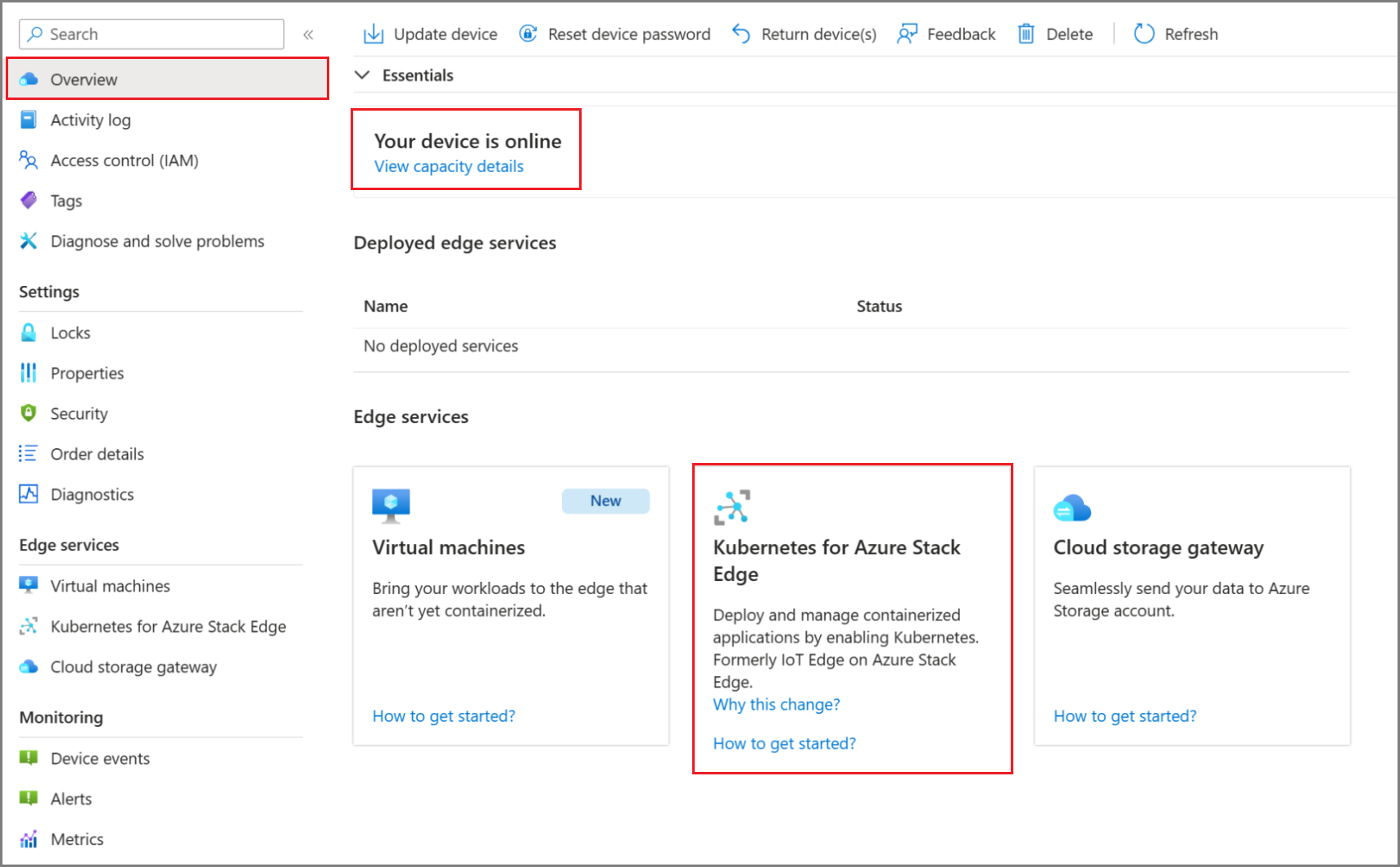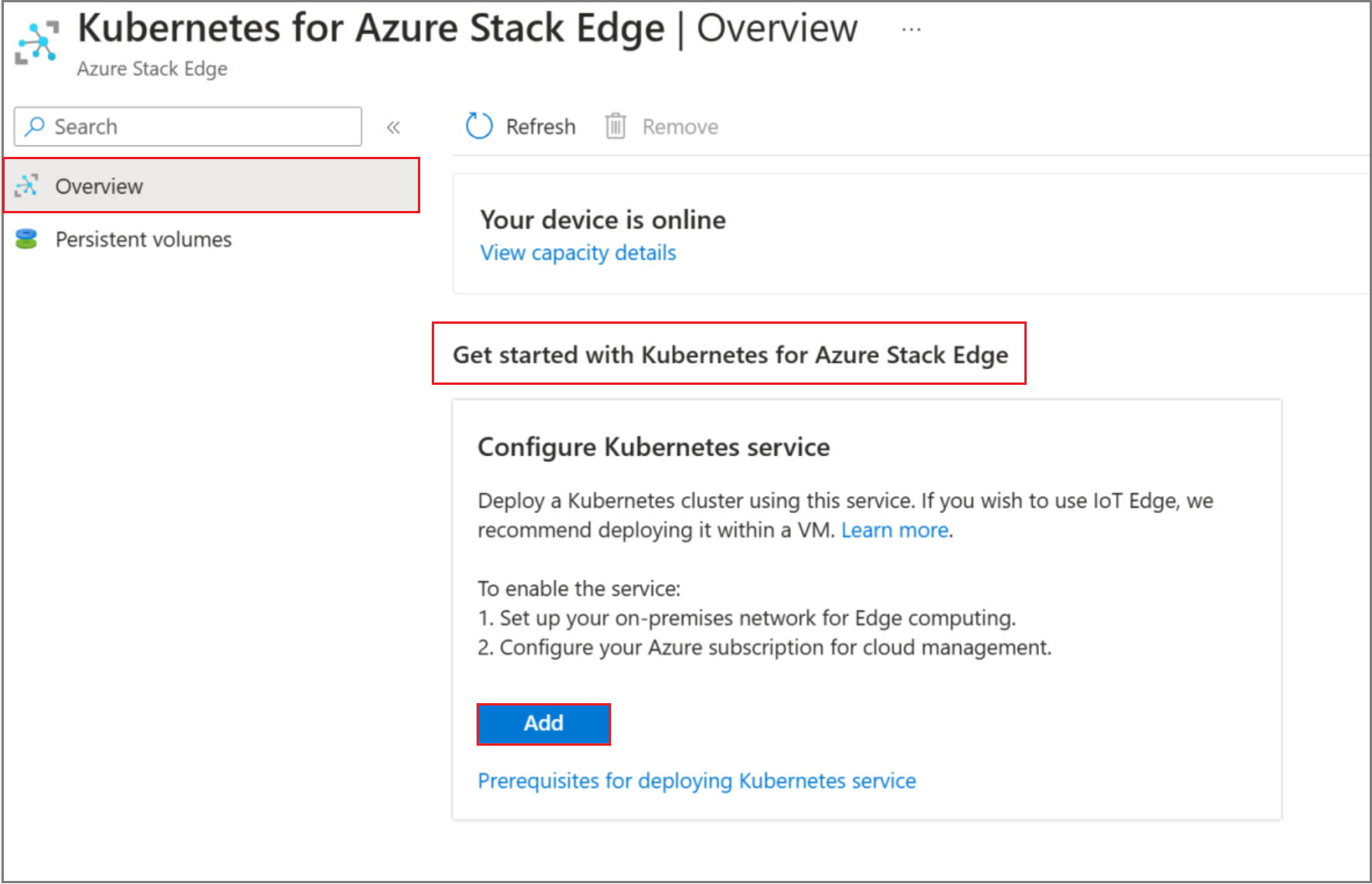Tutorial: Run a compute workload with IoT Edge module on Azure Stack Edge Pro GPU
APPLIES TO:  Azure Stack Edge Pro - GPU
Azure Stack Edge Pro - GPU Azure Stack Edge Pro R
Azure Stack Edge Pro R
Note
We strongly recommend that you deploy the latest IoT Edge version in a Linux VM. The managed IoT Edge on Azure Stack Edge uses an older version of IoT Edge runtime that doesn’t have the latest features and patches. For instructions, see how to Deploy an Ubuntu VM. For more information on other supported Linux distributions that can run IoT Edge, see Azure IoT Edge supported systems – Container engines.
This tutorial describes how to run a compute workload using an IoT Edge module on your Azure Stack Edge Pro GPU device. After you configure the compute, the device will transform the data before sending it to Azure.
This procedure can take around 10 to 15 minutes to complete.
In this tutorial, you learn how to:
- Configure compute
- Add shares
- Add a compute module
- Verify data transform and transfer
Prerequisites
Before you set up a compute role on your Azure Stack Edge Pro GPU device, make sure that:
- You've activated your Azure Stack Edge Pro device as described in Activate your Azure Stack Edge Pro.
- You have an IoT Edge module that you can run on your data. In this tutorial, we used a
filemove2module that moves data from Edge local share on your device to Edge share from where the data goes to Azure Storage account.
Configure compute
To configure compute on your Azure Stack Edge Pro, you create an IoT Hub resource via Azure portal.
In the Azure portal of your Azure Stack Edge resource, go to Overview, and select Kubernetes for Azure Stack Edge.

In Get started with Kubernetes service, select Add.

After the resource is created, the Overview indicates that the Kubernetes service is online.

It can take 20-30 minutes to configure compute because, behind the scenes, virtual machines, and a Kubernetes cluster are being created.
Add shares
For the simple deployment in this tutorial, you'll need two shares: one Edge share and another Edge local share.
To add an Edge share on the device, do the following steps:
In your Azure Stack Edge resource, go to Cloud storage gateway > Shares.
From the command bar, select + Add share.
On the Add share blade, provide the share name and select the share type.
To mount the Edge share, select the check box for Use the share with Edge compute.
Select the Storage account, Storage service, an existing user, and then select Create.

Note
To mount NFS share to compute, the compute network must be configured on same subnet as NFS Virtual IP address. For details on how to configure compute network, go to Enable compute network on your Azure Stack Edge Pro.
The Edge share is created, and you'll receive a successful creation notification. The share list might be updated, but you must wait for the share creation to be completed.
To add an Edge local share on the device, repeat all the steps in the preceding step and select the check box for Configure as Edge local share. The data in the local share stays on the device.

If you created a local NFS share, use the following remote sync (rsync) command option to copy files onto the share:
rsync <source file path> < destination file path>For more information about the
rsynccommand, go toRsyncdocumentation.Go to Cloud storage gateway > Shares to see the updated list of shares.

Add a module
You could add a custom or a pre-built module. The device does not come with pre-built or custom modules. To learn how to create a custom module, go to Develop a C# module for your Azure Stack Edge Pro device.
In this section, you add a custom module to the IoT Edge device that you created in Develop a C# module for your Azure Stack Edge Pro. This custom module takes files from an Edge local share on the Edge device and moves them to an Edge (cloud) share on the device. The cloud share then pushes the files to the Azure storage account that's associated with the cloud share.
To add a module, do the following steps:
Go to IoT Edge > Modules. From the command bar, select + Add module.
In the Add module blade, input the following values:
Field Value Name A unique name for the module. This module is a docker container that you can deploy to the IoT Edge device that's associated with your Azure Stack Edge Pro. Image URI The image URI for the corresponding container image for the module. Credentials required If checked, username and password are used to retrieve modules with a matching URL. Input share Select an input share. The Edge local share is the input share in this case. The module used here moves files from the Edge local share to an Edge share where they are uploaded into the cloud. Output share Select an output share. The Edge share is the output share in this case. Trigger type Select from File or Schedule. A file trigger fires whenever a file event occurs such as a file is written to the input share. A scheduled trigger fires up based on a schedule defined by you. Trigger name A unique name for your trigger. Environment variables Optional information that will help define the environment in which your module will run. 
Select Add. The module gets added. The IoT Edge > Modules page updates to indicate that the module is deployed. The runtime status of the module you added should be running.

Verify data transform and transfer
The final step is to ensure that the module is running and processing data as expected. The run-time status of the module should be running for your IoT Edge device in the IoT Hub resource.
To verify that the module is running and processing data as expected, do the following:
In File Explorer, connect to both the Edge local and Edge shares you created previously. See the steps

Add data to the local share.

The data gets moved to the cloud share.

The data is then pushed from the cloud share to the storage account. To view the data, you can use Storage Explorer or Azure Storage in portal.

You have completed the validation process.
Next steps
In this tutorial, you learned how to:
- Configure compute
- Add shares
- Add a compute module
- Verify data transform and transfer
To learn how to administer your Azure Stack Edge Pro device, see: